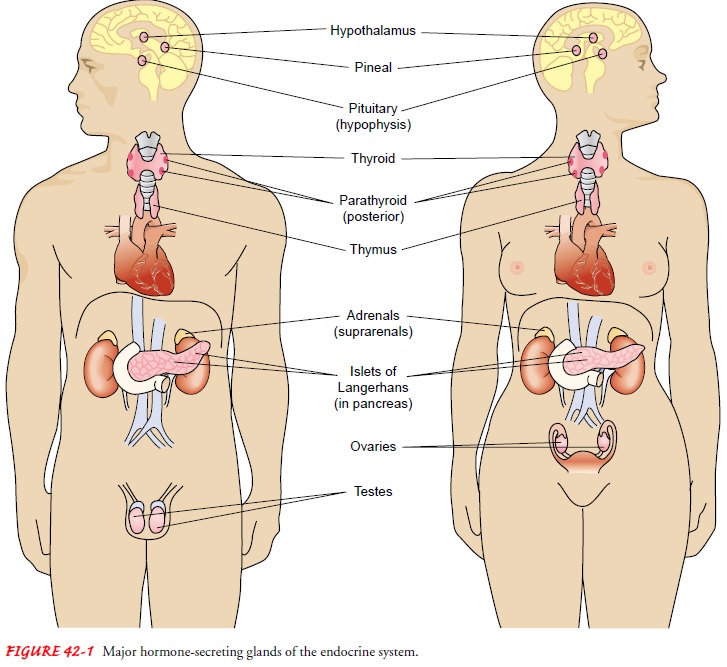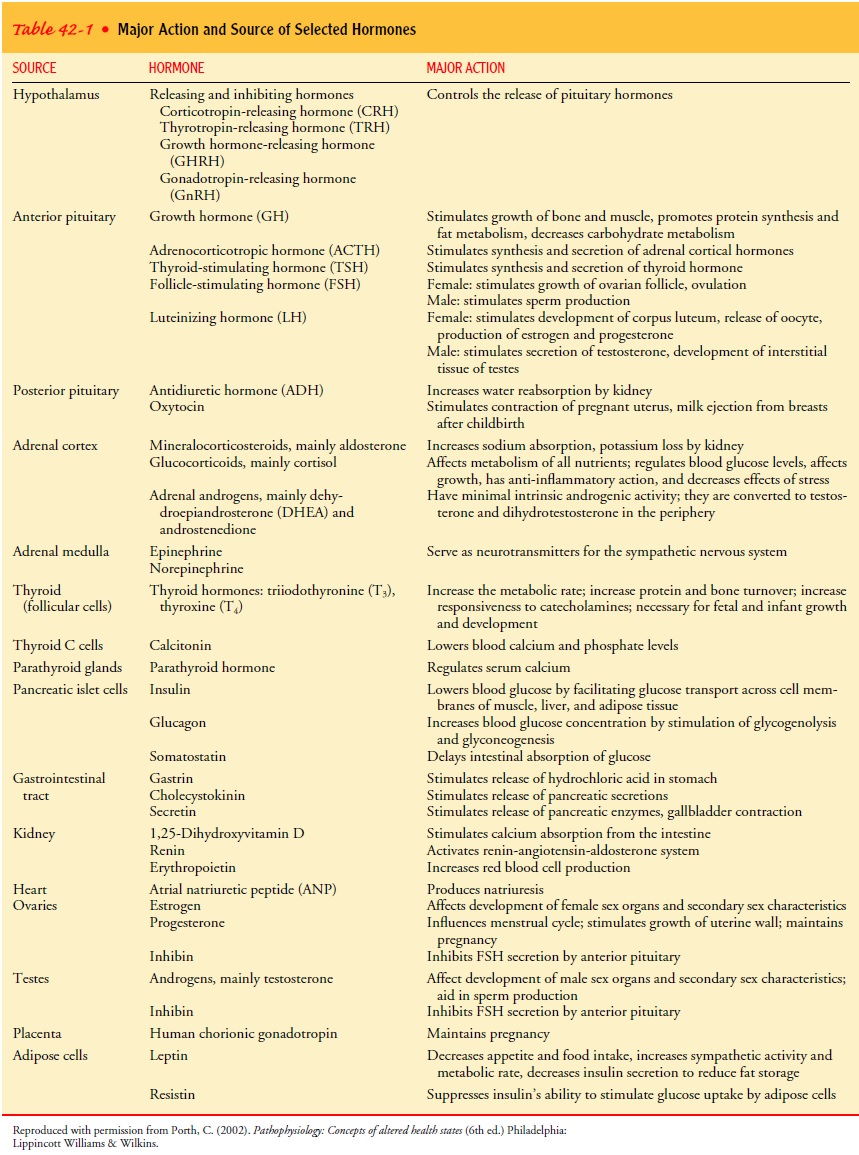Chapter: Medical Surgical Nursing: Assessment and Management of Patients With Endocrine Disorders
Endocrine System: Anatomic and Physiologic Overview

Anatomic and Physiologic Overview
The
endocrine system has far-reaching effects in the human body because of its
links with the nervous system and the immune system. The hormones secreted by
the endocrine system are affected in large part by structures in the central
nervous system, such as the hypothalamus. Other structures located in the brain,
such as the pituitary gland, are endocrine glands that influence the function
of a large number of other endocrine glands. The effects of hormones secreted
by the endocrine system affect the nervous system and are, in turn, mediated by
the nervous system. The adrenal medulla, for example, secretes a number of
substances (eg, norepinephrine and epinephrine) that act as neurotransmitters.
The immune system also interacts closely with the endocrine system. It responds
to the introduction of foreign agents by means of chemicals (eg, interleukins,
interferons) and is regulated by hormones secreted by the adrenal cortex.
In
addition to the hormones secreted by the major endocrine glands, other tissues
produce hormones that are secreted into body fluids and act on nearby cells and
tissues. The gastrointestinal mucosa produces hormones (eg, gastrin,
enterogastrone, secretin, and cholecystokinin) that are important in the
digestive process. The kidneys produce erythropoietin, a hormone that
stimulates the bone marrow to produce red blood cells. The white blood cells
produce cytokines that actively participate in inflammatory and immune
responses.
Hormones
are important in regulation of the internal environment of the body and affect
every aspect of life. Some hormones target specific tissues; for example,
adrenocorticotropic hormone (ACTH), or corticotrophin, is secreted by the
anterior pituitary gland and targets the adrenal cortex to increase the
secretion of the hormones of the adrenal cortex (ie, glucocorticoids, mineralocorticoids,
and androgens). Other hormones affect a wide variety of cells and tissues of
the body. Thyroid hormone is one example; it affects metabolic activity of
cells throughout the body.
GLANDS OF THE ENDOCRINE SYSTEM
The endocrine glands include the pituitary, thyroid, parathyroids, adrenals, pancreatic islets, ovaries, and testes (Fig. 42-1).Endocrine glands secrete their products directly into the bloodstream, which differentiates them from exocrine glands, such as sweat glands, which secrete their products through ducts onto epithelial surfaces or into the gastrointestinal tract. The hypothalamus is the link between the nervous system and the endocrine system. (Because of the unique endocrine and exocrine functions of the pancreas, pancreatic function and disorders are discussed in Chaps. 40 and 41; reproductive structures, such as the ovaries and testes, are discussed in Chaps. 47 and 49.)

FUNCTION AND REGULATION OF HORMONES
The chemical substances secreted by the
endocrine glands are called hormones.
Hormones help to regulate organ function in concertwith the nervous system.
This dual regulatory system, in which rapid action by the nervous system is
balanced by slower hormonal action, permits precise control of organ functions
in response to varied changes within and outside the body. Table 42-1 lists the
major hormones, their target tissue, and some of their properties.

The
endocrine glands are composed of secretory cells arranged in minute clusters
known as acini. No ducts are present, but the glands have a rich blood supply
so that the hormones they pro-duce enter the bloodstream rapidly. In the
healthy physiologic state, hormone concentration in the bloodstream is
maintained at a relatively constant level. When the hormone concentration
rises, further production of that hormone is inhibited. When the hormone
concentration falls, the rate of production of that hor-mone increases. This
mechanism for regulating hormone con-centration in the bloodstream is called negative feedback, which is important
in the regulation of many biologic processes.
CLASSIFICATION AND ACTION OF HORMONES
Hormones are classified as steroid hormones
(such as hydrocorti-sone), peptide or protein hormones (such as insulin), and
amine hor-mones (such as epinephrine). These different classes of hormones act
on the target tissues by different mechanisms. Hormones can alter the function of the target
tissue by interacting with chemical recep-tors located either on the cell
membrane or in the interior of the cell.
Peptide
and protein hormones interact with receptor sites on the cell surface, which
results in the stimulation of the intracel-lular enzyme adenyl cyclase. This
results in increased production of cyclic 3′, 5′-adenosine
monophosphate (cyclic AMP). The cyclic AMP inside the cell alters enzyme
activity. Thus, cyclic AMP is the “second messenger” that links the peptide
hormone at the cell surface to a change in the intracellular environment. Some
of the protein and peptide hormones may also act by changing membrane
permeability. These hormones act within seconds or minutes. The mechanism of
action for amine hor-mones is similar to that for peptide hormones.
Steroid
hormones, because of their smaller size and higher lipid solubility, penetrate
the cell membranes and interact with intracellular receptors. This
steroid–receptor complex modifies cell metabolism and formation of messenger
ribonucleic acid (RNA) from deoxyribonucleic acid (DNA). The messenger RNA then
stimulates protein synthesis within the cell. Steroid hor-mones require several
hours to exert their effects because they exert their action by the
modification of protein synthesis.
Related Topics